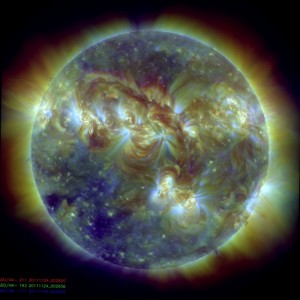In a meeting with my advisers, it was said by one of their colleagues that the AIA 211 images might be more detailed in the features to detect. Since originally I decided to use AIA 193, because visually it was easier for me to see and identify the solar cavities, I decided to try the composite image of AIA 193, AIA 211 and AIA 171. I trained this new classifier with same dates as the AIA 193 classifiers in previous posts, but with the composite images of the same date. In testing the new classifier produced, I ran it initially against the training set that was used to create the classifier, as seen in the previous post. So now we are going to start running tests on new image sets, to see how it truly performs on images it has never “seen” before.
The below hit rate was achieved when running the new composite classifier against the above single image rotated by one degree for 360 degrees.
Hit rate ≈ 100%
You can see the hit rate achieved was greater than that on just the AIA 193 classifier, but the false alarm rate is also higher.
+================================+======+======+======+ | File Name | Hits |Missed| False| +================================+======+======+======+ |20111124_002649_1024_211193171.j| 1| 0| 38| +--------------------------------+------+------+------+ |1-DEG-24_002649_1024_211193171.j| 1| 0| 36| +--------------------------------+------+------+------+ [...] +--------------------------------+------+------+------+ |358-DEG-24_002649_1024_211193171| 1| 0| 35| +--------------------------------+------+------+------+ |359-DEG-24_002649_1024_211193171| 1| 0| 40| +--------------------------------+------+------+------+ | Total| 360| 0| 14157| +================================+======+======+======+
Tags: haar training, performance, testing outcomes, trials
